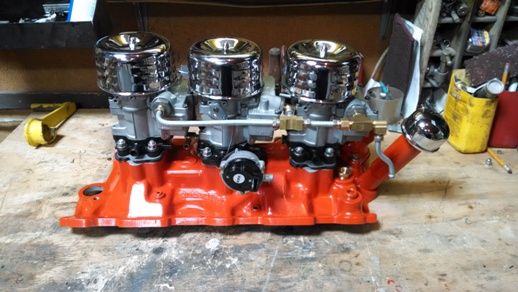Thread: Rochester jet size ?
Threaded View
-
05-22-2014 05:48 PM #11
“...........Question..........should I worry about coating the carb on the outside and making it look like new......any pluses or minuses to doing it/ not doing it.......?”
That’s a good question and one I wrestled with when my grandson and I rebuilt the carburetors on the Tri-Power setup a couple weeks ago.
Let me say this first……..how the carburetor looks on the outside will make absolutely NO difference on how it will work when it’s bolted on the engine. The important part is that it is internally clean (especially the internal passages) properly assembled and adjusted.
In the case of the Tri-Power, I’m shooting for a close to show quality engine when all is said and done. I was starting out with 3 carburetors that had “aged” differently (the end carbs are 40 years old and the center is 28 years old). The finish on each of the carbs was a bit different and it really showed up when you bolted all three to a single manifold.
The original finish on the carbs was Chromate which is a “dip” process. As far as I’m concerned it is really probably the only acceptable way to truly restore the original finish. The problem from what I’ve read is it’s somewhat complicated/time consuming to do at home, and the results are not always consistent…..which can be a problem when trying to match 3 units.
Restoring chromate finishes on carburetors | The Old Car Blog
An option would be to send out the carburetors to be re-chromated, but then you have the down time with shipping and the prices I saw ran in the $100 per carb range…..much more than I wanted to spend.
The second thing I researched was the carburetor Paint that Eastwood sells (both silver and bronze). I’ve read where people like the durability of it and I actually ordered a can of the bronze color. The problem is at anything other than a cursory glance at a distance, the carburetor looks just like what it is…….a painted carburetor. The silver may not look so bad, but at $16 (plus shipping) per small can, I’ll pass on trying any other colors.
Another option that I will be trying at some point (but not on the Tri-Power carbs) is powder coating. I’ve seen carburetors done in red and black with this process and they do look pretty good. According to Eastwood’s site, a 50/50 mix of their translucent Green and Gold Powders produces a finish that is very close to original. The powder coater up the street is going to be getting those powders in at some point and when they do I’ll be sending them a couple of sample pieces to do to see how it turns out. The one caution on the process, is that the internal passages MUST be sealed off to prevent any of the powder getting into the passages. The price I was quoted is about $35-40 per carb.
What we ended up doing on the Tri-Power carbs is actually an intermediate for most processes listed above. That is Bead Blasting the body and top. The key to bead blasting is keeping the media out of the inside of the carb. How I accomplished this was removing all the internal parts, screwing on a “junk” base plate (so I didn’t have to worry about the idle passages), then stuffed the inside tightly with balled up masking tape (which would catch media that seeped thru), then screwed the top back on and plugged EVERY hole and external passage/vacuum line. After the blasting was done, I took everything back apart and flushed everything with a can of spray carb cleaner and compressed air.
When I got done with the blasting and cleaning I was so happy with the results that I decided to leave them just as they are (the bases were just painted black). I realize the finish will eventually darken but I think I can live with that.

One last tip that comes to mind for when you assemble the carb. In the kit you should find 2 check balls. They will be different sizes, but it’s a little hard to tell without actually measuring them. In the case of the kits I’ve been getting one ball (the larger) is polished and shiny while the smaller one is not so polished looking. The smaller ball goes in the accelerator pump well. If you happen to just drop the bigger ball into the well, it can jam in the port and be a real PIA to remove. The larger ball goes under the small spring and “T” shaped retainer under the venturi assembly.
Anyway hope this helps a bit.
.Last edited by Mike P; 05-23-2014 at 04:25 AM.
I've NEVER seen a car come from the factory that couldn't be improved..... 





 12Likes
12Likes LinkBack URL
LinkBack URL About LinkBacks
About LinkBacks
 Reply With Quote
Reply With Quote

I saw last night on fb about John. The world sure lost a great one. I'm going to miss his humor, advice, and perspective from another portion of the world. Rest in Peace Johnboy.
John Norton aka johnboy